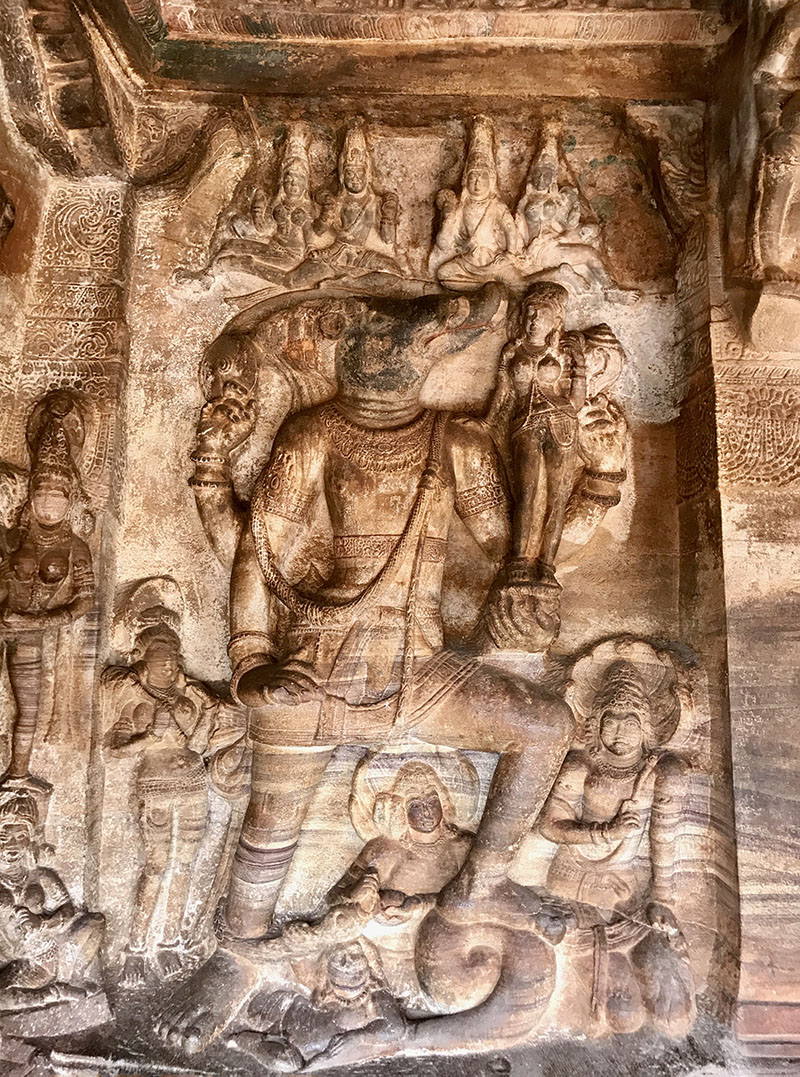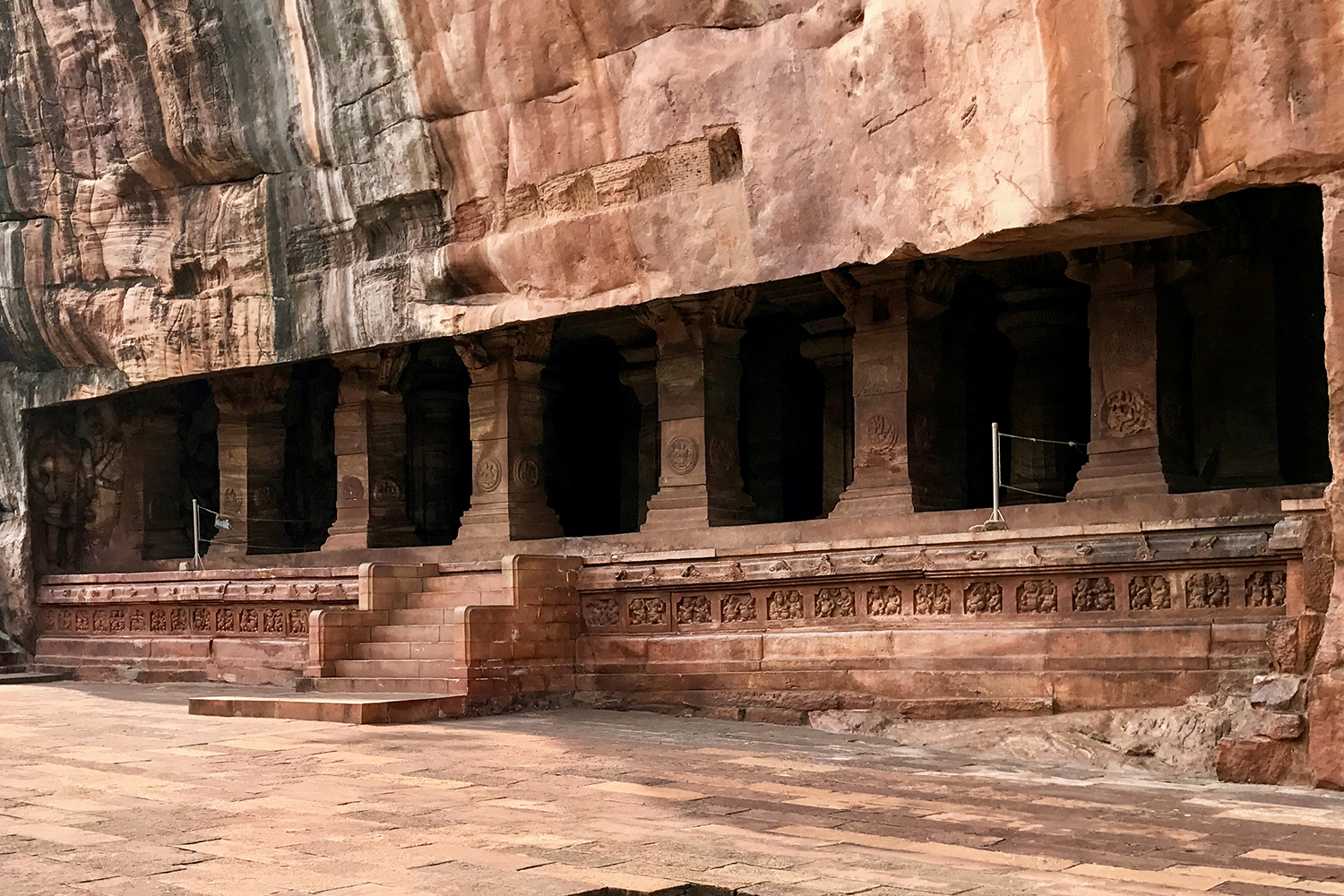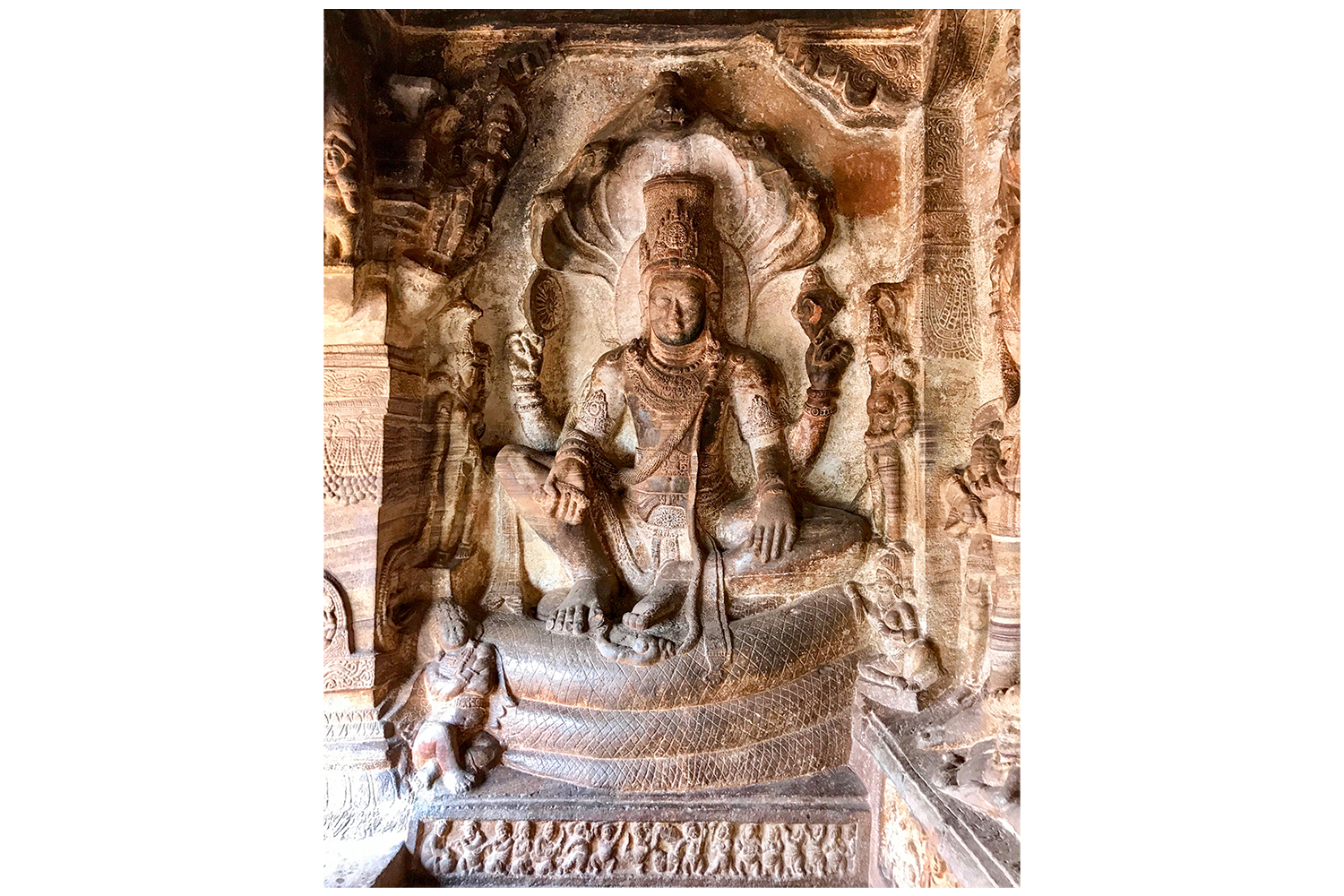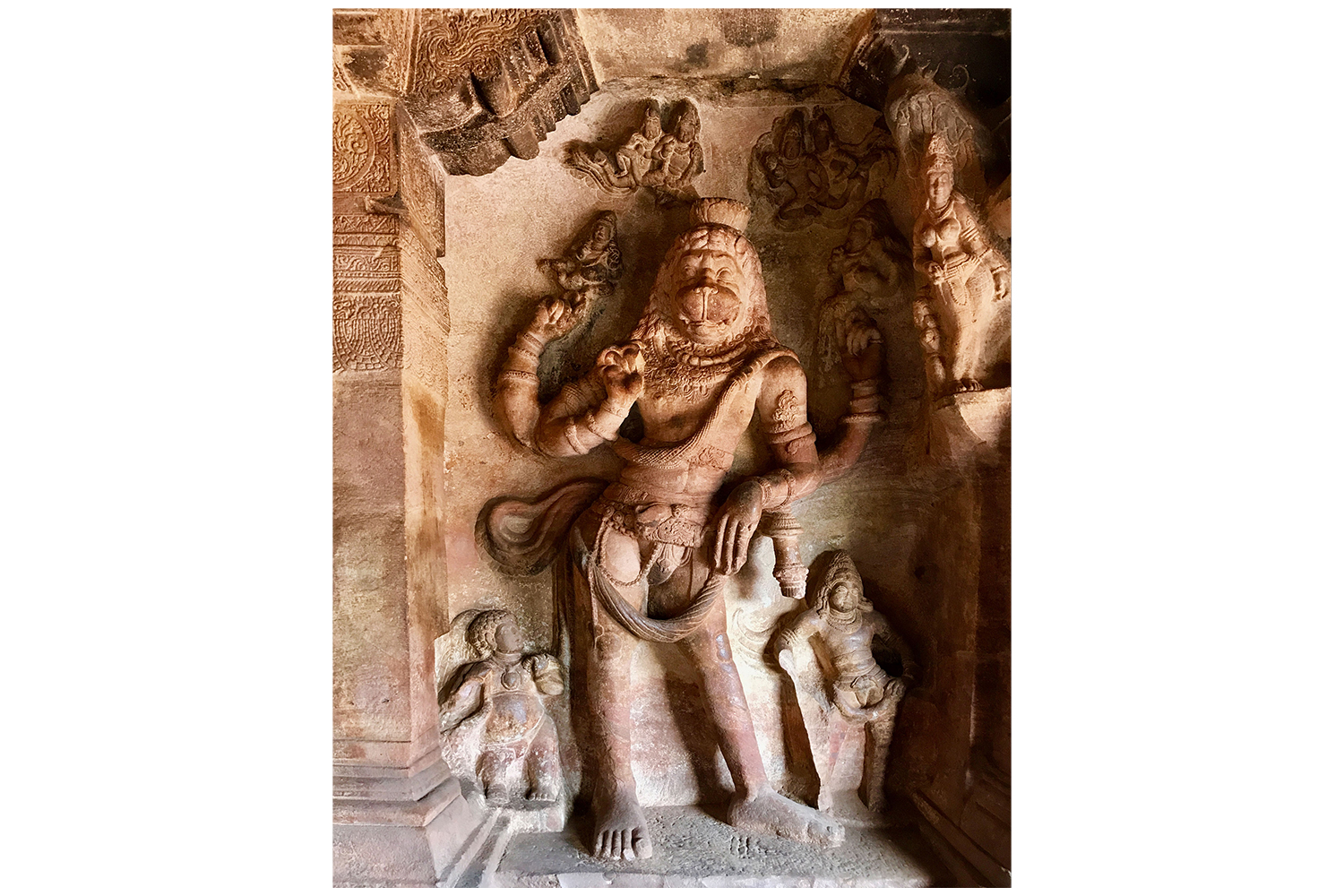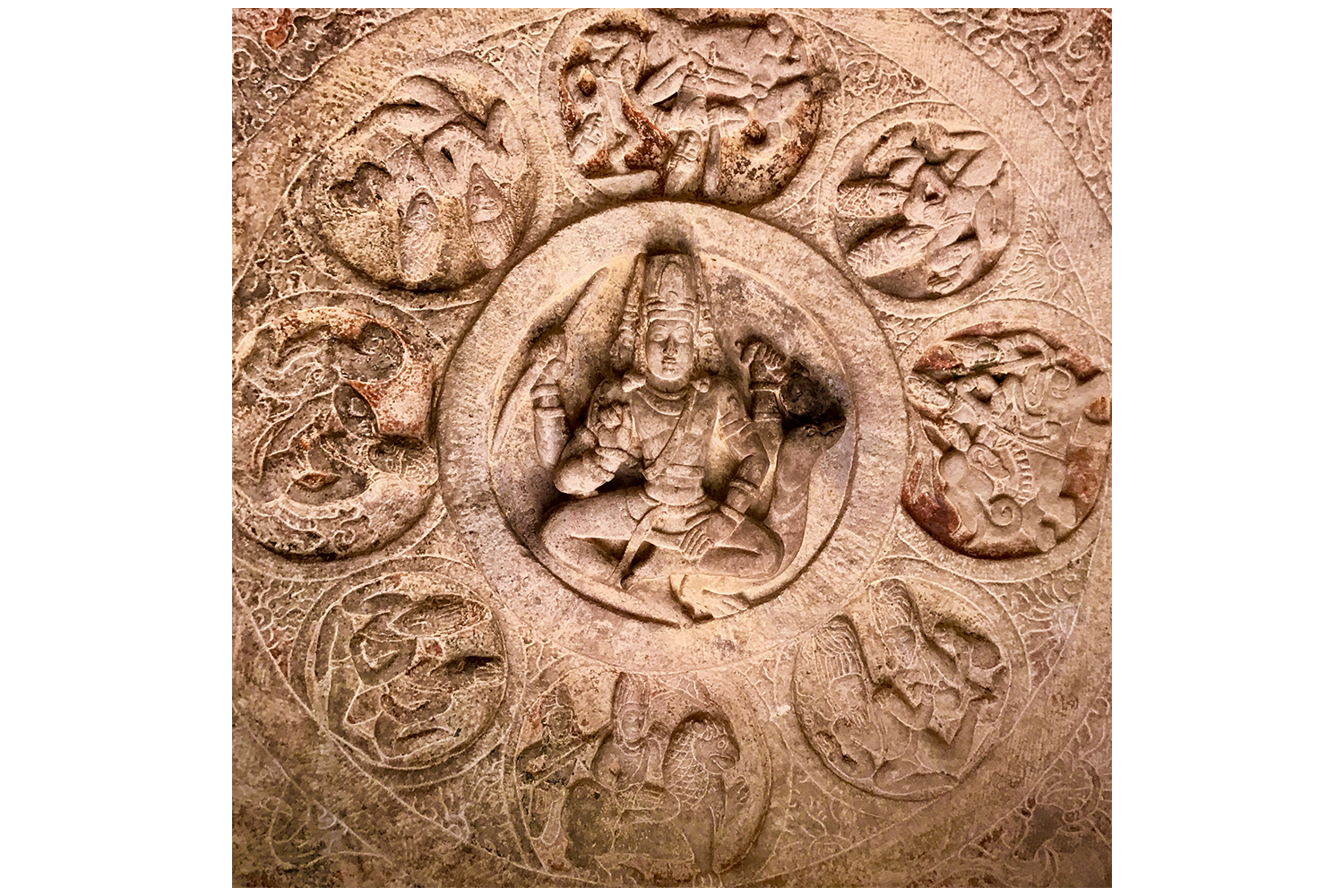ARTICLE
Badami Caves 2 and 3
On panels turned out at right angles to the porch are a matched pair of male and female dvarapalas. Besides featuring in the basement frieze, ganas also appear in the dados of the two Vishnu panels. On eastern wall of the verandah is the Bhuvaraha panel, where Vishnu is depicted rescuing Bhudevi from the demon Hiranyaksha. On the opposite end-wall is Vishnu as Trivikrama about to take his third step, also featuring the Vamana avatar and the asura king Mahabali. The two panels have their own gana dados. Above the sculpture is a kapota (entablature) featuring a complementary composition of the dancing Nataraja. On the ceiling of the central bay of the verandah is carved a wheel with a lotus hub and spokes of fish, enclosed in a floral border and two concentric square frames. This is flanked by two panels containing an arrangement of swastikas. Isolated figures of a Gandhara–Apsara couple and Vishnu–Garuda feature on the extreme east and west ceiling slabs, respectively.
In general, the sculptures of Cave 2 are carved with thick bodies in deep relief; the major sculptures are framed within well-defined panels with distinctive dados. The framing emphasises their decorative aspect, but also distances them from the viewer. This approach changes dramatically in Cave 3.
While having the same basic plan as Cave 2, Cave 3 is larger, having a seven-bayed mukhamandapa and a double-colonnaded sabhamandapa with a central open space before the garbhagriha. It displays a slight asymmetry in its façade similar to Cave 1, but without the additional shrine. The frieze of ganas in the basement is much reduced, and replaced instead by a miniature scheme of the elevation — a basement, pilasters, a kapota with kudus interspersed with hamsa birds, and pairs of ganas in niches.
The mukhamandapa is framed by a relief of ashtabhuja (eight-armed) Vishnu on the eastern flank and Trivikrama on the slightly projecting western flank. Whereas the blind bays of the preceding caves are left blank, those of Cave 3 bear a sculpture each. On the east is a large Bhuvaraha sculpture, and on the west a Harihara sculpture. On the terminal wall perpendicular to this is Vishnu seated on the multi-hooded serpent Adisesha, wearing the characteristic conical Chalukya-period headgear; on the wall on the western side, perpendicular to Harihara, is Narasimha. The deity’s legs are carved almost in the round, and his upper body originally rested on a mace or sword, which has since collapsed.
All fourteen lintels of the verandah are carved with narrative scenes depicting the Samudra Manthana and the life of Krishna. Carved and partially painted on the ceiling of the verandah are images of Varuna, Brahma, Vishnu, Yama and Indra, from east to west. The square-shafted pillars of the façade have square capitals and are offset by finely articulated figure brackets that emphasise the roof reliefs. Some surviving murals on the ceiling of the front porch and cornice overhangs depict deities and motifs, as well as scenes featuring an unidentified Chalukya ruler.
The five bays that lead to the sabhamandapa are separated by round, fluted pillars with compound round capitals. The roof of the sabhamandapa above the central space is divided into a nine-part grid containing Brahma in the centre, with Indra, Kubera, Varuna and Kartikeya arranged clockwise around him. Another ceiling carving features Vishnu surrounded by what is considered the earliest known depiction of the ashtadikpalas in a dated temple. The layout of the sabhamandapa shows much affinity to the Buddhist vihara plan, indicating the still-prevalent influences of earlier Deccan cave temples. The doorway to the garbhagriha, presently devoid of its idol, shows a great deal of detail in the imagery and stylisation of its sakhas. Vidhyadhara mithunas are depicted on either sides of the door bases, and Shankhanidhi and Padmanidhi (the personified treasures of Kubera) stand between the pilasters. The garbhagriha of Cave 3 features a fully articulated uttaranga, with an elaborate architrave of kudus and barrel-vaulted roof forms (shala) with figures of deities and mithunas in them.
Of particular import are the inscriptions in a pilaster by the Bhuvaraha sculpture as well as the Bhuvaraha sculpture itself. Varaha is known to be the dynastic emblem of the Early Western Chalukyas, and it is thought that this depiction is a political allegory affirming the dynasty’s role as protectors of the realm. This inference is further strengthened by the inscription, written in old Kannada, which attributes the excavation of the cave to Mangalesha, the son of Pulakesin I, and dates the cave to the year 500 of the Saka era, or 578 CE. The Narasimha and Trivikrama sculptures have also been interpreted by scholars as signifying the martial success and virility of the Chalukya kings and their successful domination of large swathes of the Deccan.
These large sculptures demonstrate a definite shift in treatment and sensibility in that they are rendered as architectural, rather than decorative, elements. Only two of the six sculptures have dados, with the others almost flush with the floor. The elimination of frames, increase in size, curvature of the background planes, and deeper reliefs allow for more dynamicity and immediacy, bringing the deities closer to the worshippers. This defining shift presages the Chalukya temple styles of the later period, leading scholars to consider Cave 3 a cornerstone of Deccan temple architecture developments.
Bibliography
Our website is currently undergoing maintenance and re-design, due to which we have had to take down some of our bibliographies. While these will be re-published shortly, you can request references for specific articles by writing to hellomapacademy@map-india.org.




